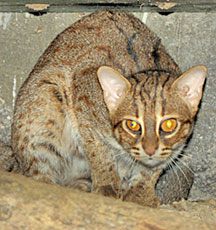|
Boost for conservation:
Dehiwala Zoo, a future research platform
By Dhaneshi YATAWARA
At times nature acts and reacts in very strange and eccentric ways.
Nature would lead a mother to reject her offspring. It was this decision
of Mother Nature that led to the tragic death of the week-old male
Bengal Tiger cub of the Dehiwala zoo almost a week ago.
 |
 |
| National Zoological Gardens Director
Bashwara Senanka Gunaratne |
Veterinary Surgeon Jagath Jayasekara |
According to veterinary surgeons of the Dehiwala zoo, the cub was
gaining 60 grams of weight per day and was weighing a little over 1.2
kilograms at the time of its death. The post-mortem on the Bengal Tiger
cub gave respiratory failure due to acute pneumonia as the cause of
death.
National Zoological Gardens Director Bashwara Senanka Gunaratne said
further tests would be carried out to determine the reasons which caused
pneumonia.
The cub’s lungs and several other tissue samples have already been
sent to the Department of Veterinary Science of the Peradeniya
University for further investigations. The week-old Bengal tiger cub
died on November 29 at the Dehiwala zoo.
“Its condition started worsening from Friday morning and it was
showing difficulty in breathing,” said Veterinary Surgeon of the
Department of Zoological Gardens at Dehiwala Jagath Jayasekara. “We gave
oxygen to the cub and nebulised it when it was experiencing breathing
difficulties,” he said.
What made the Bengal tiger mother reject her cub?
“There are three ways in which animals reject their cubs. These three
are phenomena identified across the globe. Firstly, some animals reject
feeding and caring for the cub from its birth.
“Secondly, the mother rejects the cub after feeding it for a few days
and thirdly, the induced behaviour pattern of the mother animal would
lead her to reject the cub,” Veterinary Surgeon Jayasekera said.
He explained that an elephant mother would reject its calf if it
observes that the baby will be unfit for survival in the natural
environment. “It is observed that in such instances the calf will be
kept away from the herd and left to die in the wild and in certain
instances they would even go to the extent of killing the calf”.
According to him, carnivores tend to reject their cubs more often
compared to herbivores.
Hamadryas baboon
The employees of the Zoological Gardens are raising the baby
Hamadryas baboon, Sheila which was rejected by its mother from day one.
 |
|
Fishing cats |
“The mother baboon actually tried to kill the cub by dipping it in
water, but we saved the baby after tranquillising the mother,”
Jayasekara said. Now it is eight months old and growing healthily in the
zoo nursery.
The Bengal tiger cub was rejected by its mother from birth. It is
believed that the mother, with her natural instincts, would identify
congenital abnormalities of the cub. Nature would not support carrying
the weak gene pool to the next generation, resulting in only the fittest
surviving.
A mother animal would reject the cub after feeding it for a few days
due to two reasons.
Milk is not produced in the mammary glands of some animals and in
others its glands do not release milk.The mother’s behavioural factor is
also important. Animals depend on the lessons learnt in their lives. A
mother animal would always depend on its previous experience in bringing
up its offspring. “In this case, we suspect the mother’s rejection is a
behavioural factor where she depends on her previous experience,” said
Jayasekara.
The female Bengal Tiger gave birth to three cubs on June 10, 2010.
All three had external physical deformities, especially in the limbs.
With her natural instincts the mother rejected the babies. Though the
zoo veterinary doctors and employees tried to raise them, the cubs died
within four days.
“The post-mortem revealed that the cubs had deformities in their
internal organs such as the liver which in medical terms is referred to
as congenital abnormalities,” Jayasekara said. “It is quite common in
captive breeding that certain females reject cubs,” he said. It is one
of the greatest challenges in captive breeding for animal conservation.
By nature, a mother would reject feeding the cubs for three reasons,
disturbed and unsafe environment, congenital abnormalities of the
new-born and behavioural disorders,” Jayasekara explained. As the female
tiger had a calm and safe environment for her delivery, the cub showed
no external deformities at birth and the only negative point was her
experience during her previous delivery.
Mother’s milk
Another major problem the cub faced was not being able to consume its
mother’s first milk which is called colostrum. “A baby, including
humans, should receive this milk as it gives the mother’s immunity to
the baby against possible diseases”.
 |
|
Hamadryas baboon |
As Jayasekara explained the critical period of a cub would be the
first week. “If the mother feeds the cub during this period, the animal
would get colostrum from the mother, making its immunity stronger
against infections from the external environment,” he said.
“In many instances, we had raised offspring which were rejected by
their mothers after feeding them for about a week. Raising such babies
is easier,” he said. If the mother rejects the baby from day one we find
a foster mother, he said. In two separate instances in the past, the zoo
had to raise a Fishing cat and a Rusty Spotted cat using lactating cats
as foster mothers! “If the rejected cub is of the size of a kitten we
can train the mother cat to feed the cub, accepting it in to her
litter,” he said. When the cub grows a little bigger, they bottle-feed
the animal. But the Bengal Tiger cub is the size of an adult cat.
A foster mother was an impossible alternative and bottle-feeding had
to be adopted. A milk formula especially recommended for the cat family
was given to the Bengal Tiger cub. It costs around Rs.1,500 per 250
grams. “We took every measure to minimise the indigestion condition that
normally occurs in a cub due to artificial milk.”
The cub was raised in a separate room under strict conditions as a
precaution against its weak immunity system.
It was fed every three hours with the special milk formula. It
screamed at the top of its voice, demanding the rich milk portion when
feeding time was near. It loved all the pampering it got and was very
much spoilt! It was a rare and precious moment for Sri Lanka to
contribute in our best possible way to protect an endangered species of
the world. Yet all within the rules of Mother Nature!
Indonesian advice
The Thaman Safari Park in Indonesia supported the Dehiwala Zoo during
the Bengal Tiger’s pregnancy period and delivery of the cub and is still
giving expert advice on Bengal Tigers.
This safari park carries out one of the best projects in the world in
conserving a sub-species of Bengal Tigers (Sumatran tigers). This breeds
Bengal Tigers, then release them in to the wild.
 |
|
Rusty Spotted cat
Pix : Thilak Perera |
“Expert consultant doctor Retno Sudharwathi advised and guided us
from the beginning. They faced many such challenges in their work and
their assistance will be a great support during critical moments we face
in the future,” Jayasekara said.
“What we used is one of the best standard milk formulas used in
captive breeding to raise cubs. We will keep adequate stocks ready for
similar circumstances in the future,” the Director of the Department of
Zoological Gardens said. The Department had bought a special automatic
steriliser to clean and sterilise the bottles. “If we try to dry the
milk bottles and all the equipment by hand contamination is possible. So
this is safer,” Gunaratne said.
With the birth of the cub the zoo identified many possible growth
areas. “We will be maintaining records of each and every animal and we
will be computerising them,” he said. “We need to raise the level of the
zoo to a good research platform to provide services to local and
international scientists involved in conservation,” Gunaratne said.
|

